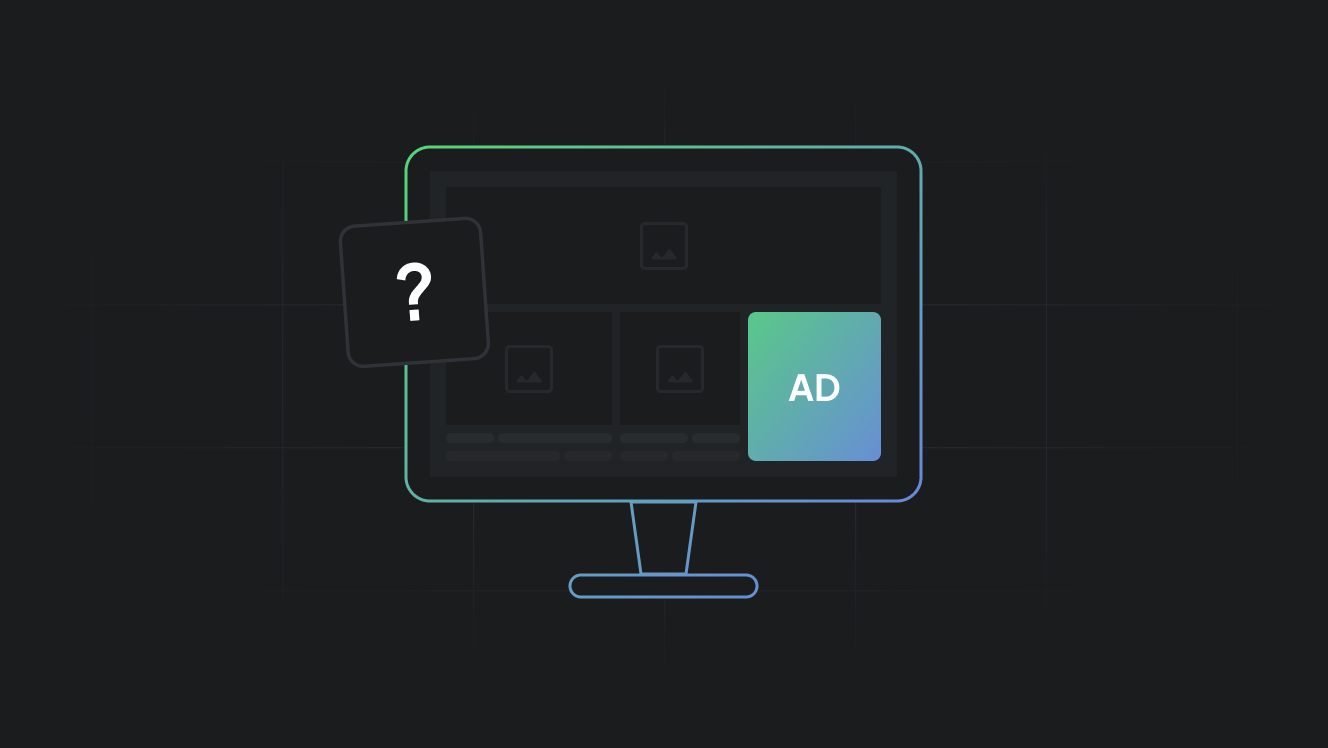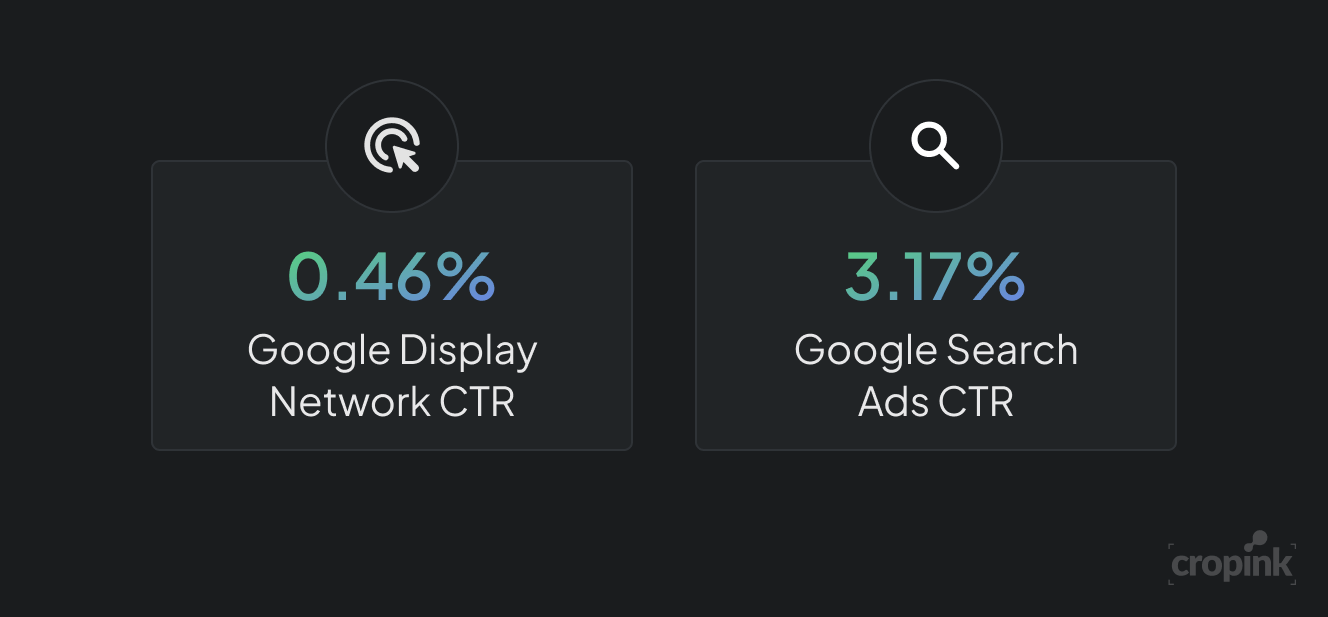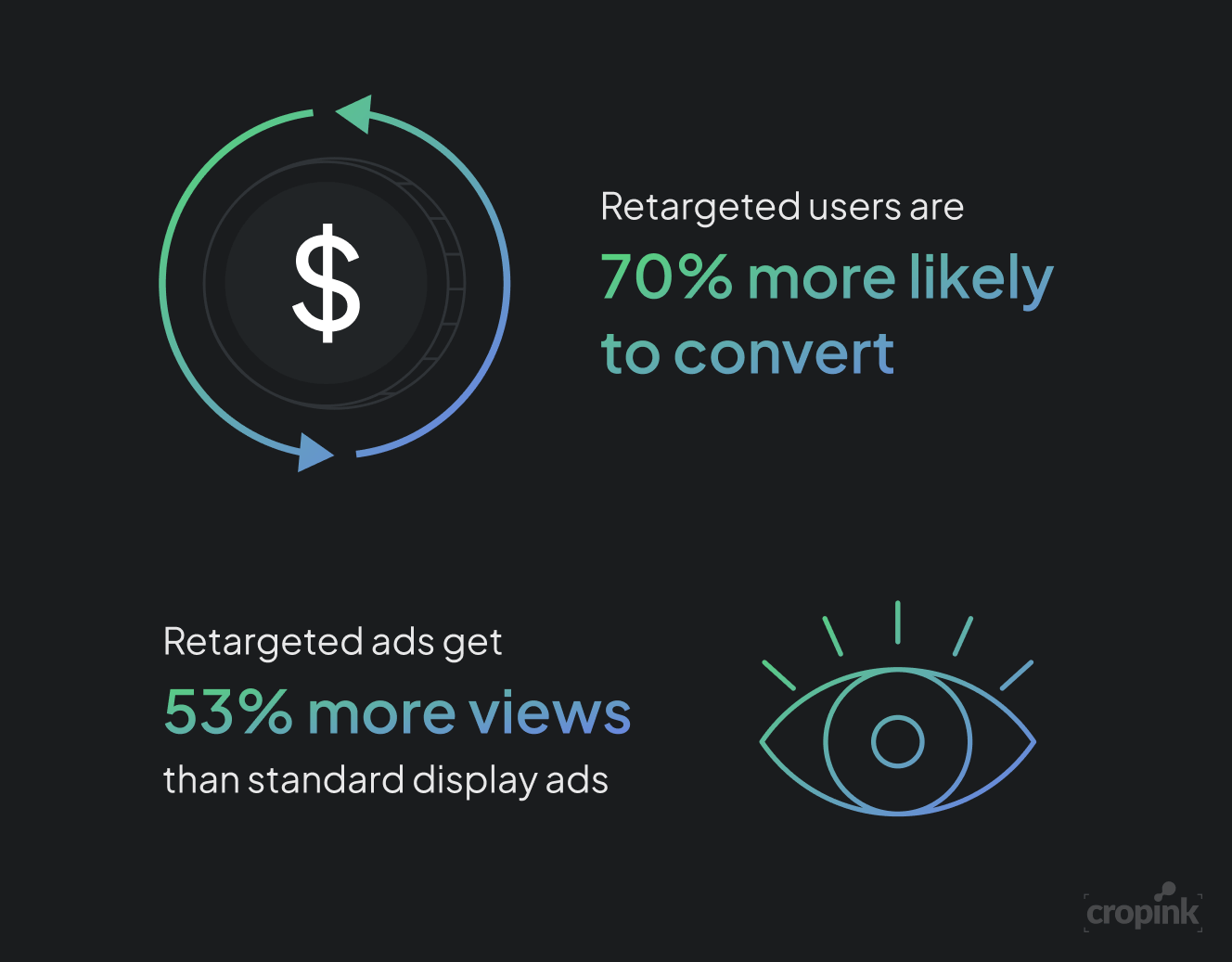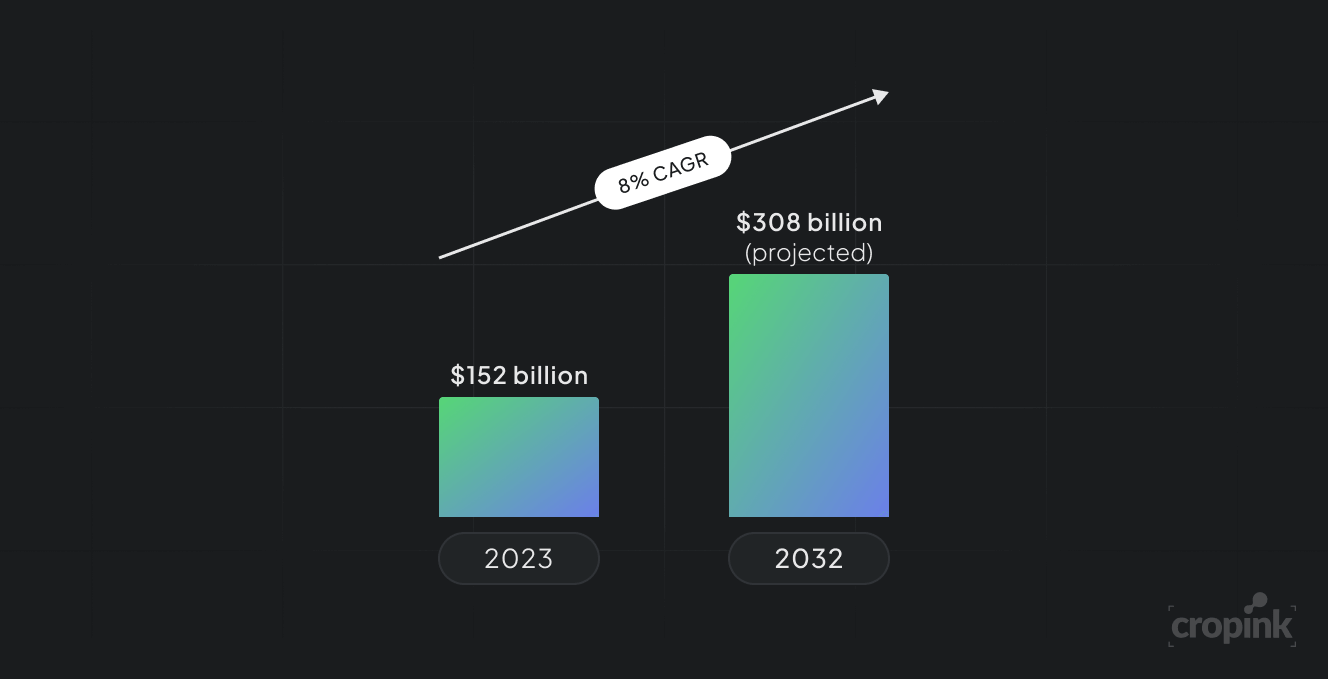Are Display Ads Effective? See How They Actually Perform in 2025
Are display ads still worth it in 2025? With Google Display reaching 90% of users and retargeting boosting conversions by 70%, the answer isn't so simple. Discover when display ads deliver real ROI—and when they don’t.



Are display ads effective in 2025, or are you wasting budget?
Many marketers struggle to see clear ROI from display campaigns. With low engagement and rising ad fatigue, it’s easy to question their value.
Yet Google’s Display Network still reaches 90% of internet users across 35 million sites and apps.
This article breaks down when display ads work, when they don’t, and how to use them effectively in your digital strategy.
Key takeaways
- Display ads are effective for brand visibility, retargeting, and staying top of mind.
- Google’s Display Network covers 90% of internet users across 35 million+ sites and apps.
- Industries like real estate and dating achieve display CTRs up to 1.08%.
- Display ads offer a low average CPC of $0.63, making them budget-friendly.
- Retargeted display ads can boost conversions by as much as 70%.
- Strong performance relies on tracking ROAS, viewability, and engagement—not just clicks.
- Most ad failures come from weak creative, poor targeting, or slow landing pages.
Are display ads still effective today?
Yes, display ads are still effective in 2025—but only if you're using them the right way.

Let’s be honest: Display ads aren’t click machines. The average click-through rate (CTR) on the Google Display Network is just 0.46%, compared to 3.17% for search ads.
That might seem low, but display was never meant to compete with search on clicks. Its strength lies in visibility, reach, and retargeting.
Certain industries are seeing strong performance. For example:
- Real estate gets the highest CTR at 1.08%
- Dating & personals follow with 0.72%
- Even industries like legal, health, and auto are hovering around 0.59–0.60%
These numbers may not sound huge, but when you're serving thousands or millions of impressions, even a fraction of a percent can generate significant traffic and conversions—especially with the right creative and targeting.
Google Display Ad Benchmarks by Industry (2025)
Click-through rates and cost per click by vertical
| Industry | CTR (Display) | CPC (Display) |
|---|---|---|
| Real Estate | 1.08% | $0.75 |
| Dating & Personals | 0.72% | $1.49 |
| Advocacy | 0.59% | $0.62 |
| Auto | 0.60% | $0.58 |
| Legal | 0.59% | $0.72 |
| Health & Medical | 0.59% | $0.63 |
| Employment Services | 0.59% | $0.78 |
| Education | 0.53% | $0.47 |
| Finance & Insurance | 0.52% | $0.86 |
| Consumer Services | 0.51% | $0.81 |
| E-Commerce | 0.51% | $0.45 |
| Industrial Services | 0.50% | $0.54 |
| Home Goods | 0.49% | $0.60 |
| Travel & Hospitality | 0.47% | $0.44 |
| B2B | 0.46% | $0.79 |
| Technology | 0.39% | $0.51 |
Why marketers still use display ads in 2025
- Massive reach: Google’s Display Network covers 90% of internet users on over 35 million sites and apps
- Affordable impressions: The average cost per click is only $0.63
- Retargeting potential: Ideal for reconnecting with previous site visitors and boosting conversions
- Visual branding: Great for brand awareness, promotions, and launching new products
If you're only chasing clicks, display ads might disappoint. But if you're using them for awareness, retargeting, or upper-funnel support, they’re still very effective.
Display ads work—just not like search ads.
They're less about instant action and more about staying visible and relevant in a crowded market. When paired with a smart strategy, they’re a powerful part of the mix.
How to measure the effectiveness of display advertising
Measuring the success of your display ads means looking beyond clicks. These eight metrics give you a clear picture of performance—reach, engagement, cost, and return.
Here’s what to track and why it matters:
1. Impressions
Impressions tell you how many times your ad was shown across websites, apps, or platforms.
This is your baseline visibility—it shows how far your campaign is reaching and how often your audience is being exposed to your message.
While high impressions can help with brand recognition, they don’t mean much if they don’t lead to clicks or engagement. Always evaluate impressions alongside more action-based metrics.
2. Click-Through Rate (CTR)
CTR shows the percentage of people who clicked your ad after seeing it. It’s one of the first signs of whether your ad is resonating with your audience.
A high CTR means your creative is engaging, your targeting is on point, and your message is compelling.
A low CTR, on the other hand, might signal that your ad design or offer needs work. It helps you quickly gauge if your ads are getting attention or being ignored.
3. Conversion Rate
Conversion rate measures how many of those clicks actually turn into meaningful actions, like signing up for a newsletter or completing a purchase.
It shows how well your landing page, offer, and funnel are working together. If your CTR is high but your conversion rate is low, you likely have a disconnect between your ad and what people see after the click.
Fixing that gap can dramatically improve results without increasing your spend.
4. Cost Per Click (CPC)
CPC tells you how much you’re paying for each click on your ad. It helps you track how efficiently you’re spending your budget.
Lower CPC generally means you’re getting more traffic for less money, but that’s not always a win.
A high-quality click that costs a bit more but leads to a sale is far more valuable than a cheap click that bounces right away. Use CPC to monitor ad efficiency, but always balance it with conversion data.
5. Cost Per Acquisition (CPA)
CPA shows how much it costs to acquire one new customer or lead. It’s calculated by dividing your total ad spend by the number of conversions.
This is one of the best metrics for understanding campaign efficiency. A rising CPA may suggest your ads aren’t targeting the right people, or your funnel needs refinement.
If your CPA is dropping while quality stays high, that’s a strong sign your campaign is working well.
6. Return on Ad Spend (ROAS)
ROAS tells you how much revenue you’re earning for every dollar spent on display ads. It’s the ultimate measure of financial return.
For example, a ROAS of 4.0 means you’re making $4 for every $1 spent. If ROAS is low, your campaign might be generating clicks but not driving profitable action.
This is your north star metric when it comes to revenue-focused campaigns, especially in e-commerce or lead generation.
7. Viewability Rate
Viewability rate measures how many of your ads were actually seen—not just served.
An ad might technically load, but if it appears below the fold or in a low-traffic zone, users might never see it.
A higher viewability rate means better exposure and stronger branding.
It also ensures you’re not wasting budget on placements that never make it onto the viewer’s screen. Aim for high-viewability placements to maximize impact.
8. Engagement Rate
Engagement rate captures how users interact with your ad—clicks, hovers, shares, video views, and more. It shows how interesting and relevant your ad is to your audience.
Even if someone doesn’t convert right away, high engagement can signal future intent or interest.
This is especially useful for upper-funnel campaigns or retargeting. Engaged users are more likely to take action later, so don’t overlook this early indicator.
Why display ads work for brand awareness and reach
Display ads aren’t built for instant clicks—they’re built for consistent visibility. If your goal is to stay in front of the right people while they browse the web, scroll apps, or watch videos, this is where display ads shine.

One big reason they work? They let you follow your audience, not wait for them to find you. With retargeting, you can re-engage visitors who’ve already shown interest.
These users are 70% more likely to convert, and retargeted ads get 53% more views than standard display ads. That’s huge for staying relevant in a crowded market.
Display ads also support subtle, ongoing exposure. Your brand might show up five, ten, or twenty times over a few days—not in a pushy way, but just enough to build familiarity.
That’s often what turns a casual viewer into a ready buyer.
And because you can target based on user behavior—like what pages they viewed, what products they browsed, or even what content they engaged with—you’re not just broadcasting.
You’re delivering timely reminders to the people most likely to care.
If you're focused on reach, recognition, and reconnecting with warm audiences, display ads are still one of the most efficient channels out there.
Real examples of display ads that get results
The best way to learn what works with display ads? Look at the brands getting real results—and stealing a few smart moves from them.
- Coca-Cola ran a campaign called Create Real Magic, blending AI-generated art and branding. It got people involved, not just watching. That’s what happens when creativity meets tech.
- Calm, the meditation app, didn’t redesign their product—they just used smarter display targeting. With better content recommendations powered by Amazon Personalize, they boosted app usage by 3.4%.
- Julian Bakery scaled fast using Google Display Ads. They cleaned up their creative and targeting and saw a 330% jump in impressions—plus 35% more conversions. That’s what happens when your visuals match your audience.
- Heineken Light launched a quick-hit video campaign on Facebook. In just three days, they reached 35 million people. Display ads might not always get clicks, but they absolutely build brand reach when you go big on visuals.
- Glymnis, a fitness gear brand, used Amazon Video Ads to show their products in action. Simple, scroll-stopping clips helped boost engagement on product pages—proof that motion > stills when you're selling online.
If you want to see more of how formats like carousel, product, and interactive ads work, check out our social media ad formats guide. These aren’t just “nice to have”—they’re performing for real businesses every day.
Display advertising statistics that show what works

Display advertising isn’t hype—it’s growing fast because it delivers results. In 2023, the global display ad market hit $152 billion, and it’s expected to double to $308 billion by 2032, growing at 8% CAGR. That’s not a trend—it’s a long-term shift.
What’s fueling it? Simple. More internet users, more smartphones, and better tools. As people spend more time online, advertisers follow. That’s why programmatic display advertising is taking over—it automates ad buying in real time, making it faster and more efficient for everyone.
Advanced targeting is also playing a big role. Thanks to AI and analytics, marketers can now run hyper-personalized campaigns, leading to higher click-through and conversion rates. You’re not just putting your ad out there—you’re showing the right message to the right person at the right time.
Zoom out to the bigger picture: the global internet advertising market will reach $500 billion by 2025, and it’s set to grow another 12% annually through 2033. That means more budget, more innovation, and more pressure to run campaigns that actually perform.
Display ads are a huge piece of that. Especially for ecommerce, which is now the top segment driving ad spend.
Online retail brands are investing heavily in display to boost visibility, retarget browsers, and drive conversions—because it works.
Programmatic platforms are helping brands do this at scale. And the payoff? Brands like JPMorgan Chase saw up to a 450% increase in CTR using AI-powered ad copy.
Others, like Calm and Julian Bakery, boosted user engagement and conversions using smart display placement and video.
Even regionally, display is expanding. Asia-Pacific is the fastest-growing market, thanks to rising smartphone adoption and digital access. North America still leads in spend, but the growth is happening globally.
If you’re not investing in display yet, now’s the time. The numbers speak for themselves. It’s not just growing—it’s evolving, fast.
Common problems that reduce display ad performance
Even the best campaigns can flop if the basics aren’t right. These are the most common reasons your display ads might be underperforming—and how to fix them.
Bad creative = bad first impression
If your ad looks cluttered, messy, or off-brand, people scroll right past it. Poor visual design kills attention fast.
Blurry or low-quality images make your ad look unprofessional. Don’t expect clicks if your creative looks like it was made in Paint.
Your message matters too. If it’s vague, irrelevant, or confusing, people won’t care. You need a clear offer and value upfront.
And using the same ad over and over? That leads to ad fatigue—people tune it out because they’ve already seen it 10 times.
Targeting that misses the mark
Bad targeting means your ad ends up in front of the wrong people. No interest = no clicks = wasted budget.
But hyper-specific targeting can also backfire. If your audience is too small, your reach tanks—and so does performance.
And yes, showing your ad too often is a problem too. High frequency makes users annoyed, not interested.
Tech issues that kill conversions
Slow-loading ads are a big drop-off point. People won’t wait. If your creative takes forever to appear, they’re gone.
Unresponsive design is just as bad. If your ad looks broken on mobile, you lose trust—and clicks.
Ad fatigue and invisibility
People see thousands of ads daily. Ad blindness is real. If yours doesn’t stand out, it gets ignored.
Plus, if you’re not updating creatives often, you’re not giving users anything new to react to. That means less engagement over time.
Privacy is changing the game
Privacy laws and ad blockers are cutting off data. That makes targeting harder and personalization weaker.
Less data = less precise ads = lower performance. This is why creative quality matters more than ever.
Bot clicks waste your spend
Click fraud is a real thing. Bots and bad actors can inflate your metrics and burn your budget without giving you anything in return.
Always keep an eye on your analytics and filter out suspicious activity before it drains your ROI.
Your landing page is blowing it
Even if your ad is great, a slow or confusing landing page ruins the whole experience. People drop off before they convert.
Pages need to load fast, look clean, and clearly match the ad they clicked. No surprises, no clutter.
Make your creative count with Cropink
If you’re struggling with ad quality or creative fatigue, Cropink can help. It’s built for marketers who want better display ads—faster.
With custom templates, real-time previews, and product feed integration, you can build and launch scroll-stopping display ads across platforms—without needing a designer.
Even better? You can start for free with up to 25 products, and upgrade only if your needs grow. Check out Cropink’s ad builder to see how it works.
FAQs
Display advertising can be effective by increasing brand visibility, retargeting website visitors, and supporting top-of-funnel awareness. It’s great for keeping your brand in front of users across websites, apps, and social platforms—even if they don’t click right away.
What makes display ads successful is strong creative, accurate targeting, and clear messaging. The best-performing ads are visually clean, mobile-optimized, and personalized to the audience. Success also depends on using the right formats—like video, carousel, or product ads—for your campaign goal.
Display advertising is cost effective because it offers low average CPCs (around $0.63) and wide reach across millions of sites. With tools like programmatic buying and retargeting, you can maximize visibility and engagement without overspending—especially compared to higher-cost channels like search or TV.
Final thoughts
So—are display ads effective in 2025? Absolutely, but only when used with the right strategy.
They’re not meant to compete with search ads for clicks. Their strength is in visibility, retargeting, and brand recall. With smart targeting, fresh creative, and a well-optimized funnel, display ads can drive real business results.
If your ads aren’t performing, the problem likely isn’t the channel—it’s how you’re using it. Fix the creative. Fix the targeting. Fix the landing page. And watch your ROI improve.
Need help making better product ads, faster? Try Cropink’s ad builder and turn your feed into ready-to-run display creatives—no design skills needed.
Sources
- Keywords Everywhere. 64 Game-Changing Display Advertising Stats You Need To Know
- WordStream. Google Ads Benchmarks for YOUR Industry [Updated!]
- Demandscience. How to Measure Display Advertising Campaign Success
- WebFX. Is Display Advertising Effective?
- Cropink. 8 Most Effective Social Media Ad Formats [With Specs, Examples & Tips]
- Cropink. 10 Most Important Advertising Trends to Watch
- Data Intelo. Display Ads Market Outlook
- MRA. Global Internet Ad Spending Market

Ansherina helps brands create powerful digital marketing and performance marketing strategies. With a passion for ad design and audience engagement, she is dedicated to making brands more visible and impactful.

Leszek is the Digital Growth Manager at Feedink & Cropink, specializing in organic growth for eCommerce and SaaS companies. His background includes roles at Poland's largest accommodation portal and FT1000 companies, with his work featured in Forbes, Inc., Business Insider, Fast Company, Entrepreneur, BBC, and TechRepublic.
Related Articles
Discover how to tap into Facebook Messenger’s 947 million users in 2026. Learn how Messenger ads drive real engagement by starting direct conversations—right where your audience is already active.

Find out how Revolve, Uniqlo, and other top apparel brands convert customers with clothing ads. We examine 9 examples and show you how to apply the same strategies to your apparel store.

Wondering what PMax campaigns are? Learn how Google’s fully automated ad campaigns use machine learning to boost conversions by up to 39% and lower CPA by 75%. See how PMax works across Search, Shopping, YouTube, and other major Google platforms in one campaign.

Without ad intelligence, every campaign you put out is a coin toss. Learn how ad intelligence works and why it’s a must-use for anyone who wants profitable advertising.

That product you looked at once is now everywhere you scroll. It's not a coincidence. This guide shows you how retargeting works, why businesses depend on it, and the steps you can take to stop ads from following you around.

Facebook raked in $164.5B in ad revenue in 2024—but are your ads pulling their weight? Discover the Facebook ad metrics that truly matter (CTR, CPC, ROAS) and learn how to optimize for real results, not just likes and shares.

Discover 16 of the best fashion ad examples from 2025, in a global market worth $1.84 trillion with over 2.8B users projected by 2029. Learn why these campaigns work — from cinematic minimalism to social-first UGC — and how to apply the same strategies to make your ads stand out.

Targeted ads double conversion rates by using AI, real-time tracking, and your data. See how it works—and how privacy laws are changing it.

Master the 12 essential digital ad types for 2025—learn which formats drive conversions, recover lost leads, and match your goals to your audience’s behavior. Avoid wasted budget and boost ROI with smart ad choices.

Brands love to get clever with their messaging, but sometimes, that cleverness crosses into manipulation. We break down 10 common advertising fallacies big brands use to sway you. You'll see real examples, learn why they work, and decide if you'd ever dare to use them yourself.

With 38% of Americans relying on social media for news, misleading advertising has never been riskier. Discover 7 real examples where small exaggerations led to lawsuits, brand damage, and lost trust—and why transparency is no longer optional.

Ad blockers usage statistics 2025 reveal key trends. Find out who’s blocking ads, their reasons, and how it impacts online advertising.

How Can Cropink Help?
Start with Cropink is easy and free
No credit card required